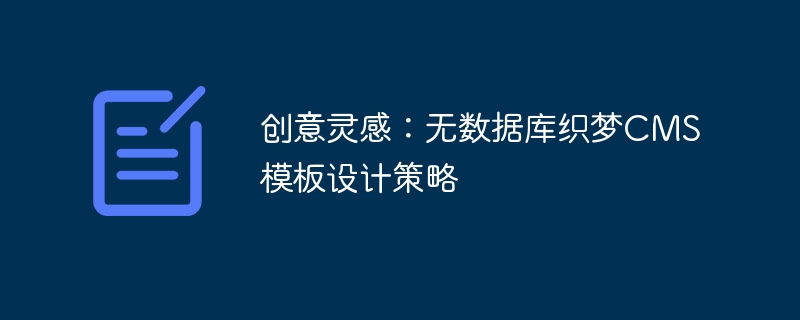Home >Backend Development >PHP Tutorial >Creative inspiration: Database-free DreamWeaver CMS template design strategy
Creative inspiration: Database-free DreamWeaver CMS template design strategy
- 王林Original
- 2024-03-14 09:45:04845browse

Creative inspiration: Database-free Dreamweaver CMS template design strategy
In the Internet era, website construction has become more and more common, and Dreamweaver CMS is a simple The easy-to-use website management system is favored by many webmasters. However, in actual use, database management backup and security considerations have led some webmasters to try database-less Dreamweaver CMS template design. This article will introduce some database-free CMS template design strategies and give specific code examples.
1. Static pages
The key to database-free CMS template design is to make dynamic pages static, that is, to generate static HTML pages from pages that originally dynamically obtain content from the database. The advantage of this is that it can reduce server pressure, increase website opening speed, and also reduce database management worries.
There are many ways to implement static pages in DreamWeaver CMS, among which the more commonly used one is to use the system tag {dwt}, that is, the data template tag, and cooperate with pseudo-static rules to achieve it. The following is a simple sample code:
{php}
$article_id = $aid ? $aid : 1;
require_once(DEDETEMPLATE."/default/article_{$article_id}.htm");
{/php}In the above code, $aid represents the ID of the article, and the corresponding static page is dynamically generated by obtaining the ID of the article. In the template file, different template files can be introduced according to different IDs to achieve the presentation of different articles.
2. Cache-based page management
In addition to static pages, cache-based page management is also a good choice. Caching can reduce frequent access to the database and improve the response speed of the website. Dreamweaver CMS comes with some caching mechanisms, such as full-site caching, page caching, etc. You can make full use of these functions when designing templates.
The following is a simple code example that utilizes site-wide caching:
{dede:global nocache}
{$article_id = $aid}
{dede:global}By using the {dede:global nocache} tag, part of the content in the template file can be excluded from the cache. Implement management of dynamic content.
3. File caching technology
In addition to using the caching mechanism of Dreamweaver CMS itself, you can also use file caching technology to improve website performance. Reduce database access by keeping some static data in files.
The following is a simple file caching code example:
$file_path = 'cache/data.txt';
if (file_exists($file_path)) {
$data = file_get_contents($file_path);
} else {
$data = '这是一段静态数据';
file_put_contents($file_path, $data);
}With the above code, static data can be saved in the data.txt file, read from the file when accessed for the first time, and then Obtain data directly from files, reducing the number of database visits.
To sum up, the database-less Dreamweaver CMS template design requires some design strategies on static pages, caching mechanism and file caching technology. By rationally utilizing these methods, the performance of the website can be improved, the dependence on the database can be reduced, and the website can be made more secure and reliable. I hope the above content is helpful to everyone, and you are welcome to provide more creative inspiration!
The above is the detailed content of Creative inspiration: Database-free DreamWeaver CMS template design strategy. For more information, please follow other related articles on the PHP Chinese website!

